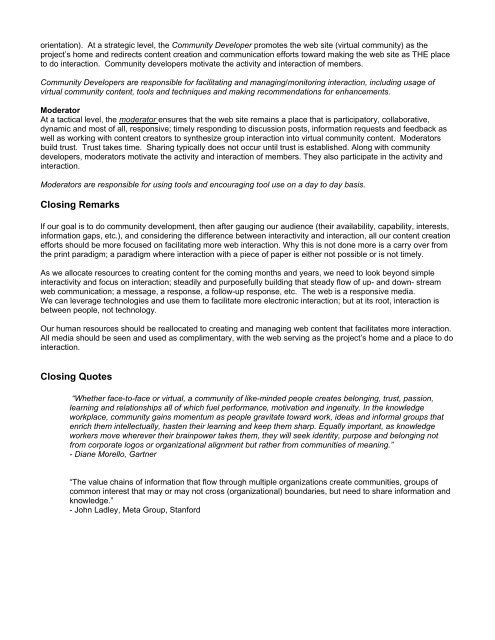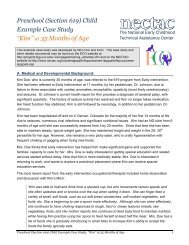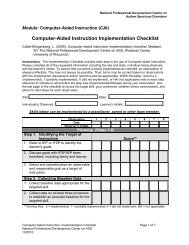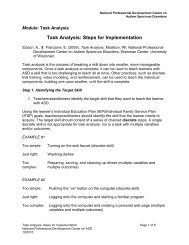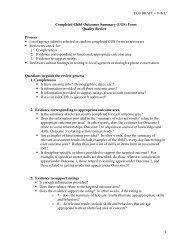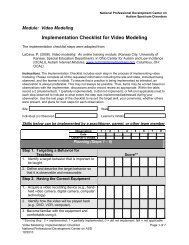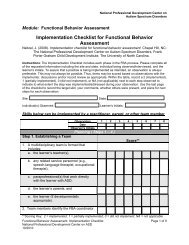Virtual Communities for Communication and Interaction
Virtual Communities for Communication and Interaction
Virtual Communities for Communication and Interaction
You also want an ePaper? Increase the reach of your titles
YUMPU automatically turns print PDFs into web optimized ePapers that Google loves.
orientation). At a strategic level, the Community Developer promotes the web site (virtual community) as theproject’s home <strong>and</strong> redirects content creation <strong>and</strong> communication ef<strong>for</strong>ts toward making the web site as THE placeto do interaction. Community developers motivate the activity <strong>and</strong> interaction of members.Community Developers are responsible <strong>for</strong> facilitating <strong>and</strong> managing/monitoring interaction, including usage ofvirtual community content, tools <strong>and</strong> techniques <strong>and</strong> making recommendations <strong>for</strong> enhancements.ModeratorAt a tactical level, the moderator ensures that the web site remains a place that is participatory, collaborative,dynamic <strong>and</strong> most of all, responsive; timely responding to discussion posts, in<strong>for</strong>mation requests <strong>and</strong> feedback aswell as working with content creators to synthesize group interaction into virtual community content. Moderatorsbuild trust. Trust takes time. Sharing typically does not occur until trust is established. Along with communitydevelopers, moderators motivate the activity <strong>and</strong> interaction of members. They also participate in the activity <strong>and</strong>interaction.Moderators are responsible <strong>for</strong> using tools <strong>and</strong> encouraging tool use on a day to day basis.Closing RemarksIf our goal is to do community development, then after gauging our audience (their availability, capability, interests,in<strong>for</strong>mation gaps, etc.), <strong>and</strong> considering the difference between interactivity <strong>and</strong> interaction, all our content creationef<strong>for</strong>ts should be more focused on facilitating more web interaction. Why this is not done more is a carry over fromthe print paradigm; a paradigm where interaction with a piece of paper is either not possible or is not timely.As we allocate resources to creating content <strong>for</strong> the coming months <strong>and</strong> years, we need to look beyond simpleinteractivity <strong>and</strong> focus on interaction; steadily <strong>and</strong> purposefully building that steady flow of up- <strong>and</strong> down- streamweb communication; a message, a response, a follow-up response, etc. The web is a responsive media.We can leverage technologies <strong>and</strong> use them to facilitate more electronic interaction; but at its root, interaction isbetween people, not technology.Our human resources should be reallocated to creating <strong>and</strong> managing web content that facilitates more interaction.All media should be seen <strong>and</strong> used as complimentary, with the web serving as the project’s home <strong>and</strong> a place to dointeraction.Closing Quotes“Whether face-to-face or virtual, a community of like-minded people creates belonging, trust, passion,learning <strong>and</strong> relationships all of which fuel per<strong>for</strong>mance, motivation <strong>and</strong> ingenuity. In the knowledgeworkplace, community gains momentum as people gravitate toward work, ideas <strong>and</strong> in<strong>for</strong>mal groups thatenrich them intellectually, hasten their learning <strong>and</strong> keep them sharp. Equally important, as knowledgeworkers move wherever their brainpower takes them, they will seek identity, purpose <strong>and</strong> belonging notfrom corporate logos or organizational alignment but rather from communities of meaning.”- Diane Morello, Gartner“The value chains of in<strong>for</strong>mation that flow through multiple organizations create communities, groups ofcommon interest that may or may not cross (organizational) boundaries, but need to share in<strong>for</strong>mation <strong>and</strong>knowledge.”- John Ladley, Meta Group, Stan<strong>for</strong>d


